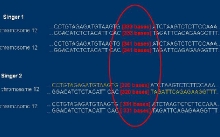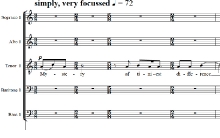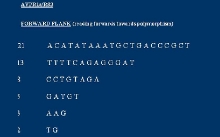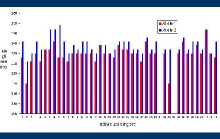When Andrew Morley first approached me about Allele, and we discussed the idea of turning genetic material into music, I was startled and bemused. And yet the moment he showed me the endlessly varying patterns in genes - built from just four chemical bases and represented by the letters, A, C, G and T - I immediately saw the potential for music there. A could be the note A, C and G similarly, while T using the solfege doh-re-mi scale would be B. This could be my starting point. Later, as the piece unfolded, the letters would be mapped onto other pitches and rhythmic shapes too, so flowering into something more complex and elaborate.
There is, in fact, a whole chapter of musical history which involves turning names into musical notes – BACH is only the most famous – and this piece would, in part, be my contribution to this way of making music too, I thought. And yet, I knew that there was an enormous difference between a four-note pattern such as BACH threaded through a piece, and the potential of more than 3 billion letters (in pairs) in the human genome! How was I going to limit this material, and yet use enough of it to make the piece meaningfully connected to it? How was I going to do this and make something that would not be a mere automatic musical representation of the sequence, but a meaningful aesthetic response?
Limitations and aesthetics came out in various ways. Andrew supplied me early on with various portions of different genetic areas he was going to be focussing on, and I tried bits of them out for melodic shapes. One soon seemed to me especially attractive, recalling the lilt of plainsong, and I went with it. Rooting the sound of the piece in the familiar, yet knowing I was going on a journey to the unfamiliar, felt right – and chimed with my approach in other work too.
Then I knew that the crux of the study, and the climax of my music, was going to focus on the tiny points of difference in the genome, which contribute to our individuality: the alleles. And I began to think how I could structure the whole piece around these points. I learnt how such polymorphisms, as they can also be called, are flanked by material common to all of us, a forward flank and a backward one (fig 1). And I had the thought that one way of defining the sections of the piece would be to ‘walk along’ the flanks of letters in different ways, approaching each time the crucial point of difference.
I limited my ‘walks’ up to the alleles, through the use of the Fibonacci Sequence and connected Golden Section. This series of numbers and ratio crop up in the formation of many natural forms. And though there is no defining evidence that this formation is found in genes (though some argue for it), it felt appropriate to use it as a constructional basis for a piece to do with nature. The beginning of the sequence is this: 1, 1, 2, 3, 5, 8, 13, 21, 34, 55. And I used it to give me precise groupings of the letters, corresponding to musical phrases, in the flanks (fig 2). It also defined the lengths and proportions of larger sections of the piece, and the biggest climax indeed concludes at the Golden Section, which is 0.618 of the way through.
And I went one stage further, as Ruth Padel relays, and that was to ask her to structure the lines she wrote in the same way. For it seemed to me that if I was going to stick as closely as I could to the ordering of the genetic sequence, the piece would be further strengthened and integrated if the structuring of the words was the same as that of the music.
But though the mathematical correlation was important to me, still more so was the the shared tone of the words and music. As we both travelled the long learning curve of understanding how genes work, we grasped the hard matter, and marvelled all the more at the wonder of the thing. It is the wondering mystery that the words speak most of for me – and it is that which the music aims to conjure, as it unfolds its genetic sequences (fig 3).
I took one other genetic image for that unfolding, and it was the idea of replication. I saw the total number of parts as a goal to be arrived at extremely gradually, starting at 1, moving to 2, then 5, 10, 20 and finally 40. But the resources of a choir of 40, divided into 8 times 5 mini-choirs, provided many more textural possibilities than that. And the ultimate arrival at all the singers singing different parts turned out to be reached through a very varied set of textures and combinations.
Curiously, perhaps, the idea of writing for large choir was not in our initial discussions at all – we first talked about a work for orchestra, even string quartet. Yet Andrew and I soon came to feel that singing the material would add a vital extra human quality and immediacy. And the thought of the suitably monumental forces of Tallis’s Spem in Alium, and the tradition it has spawned, quickly followed.
When the singers reach the word ‘Allele’ in the text, I decided it would be the moment that they turn away from the common genetic material to sing their own unique variants. It was, in the composition process, the place I had most been waiting for. But how to match this in the music? The data Andrew gave me here was in fact not a series of letters, but a set of lengths: 309, 311, 315, 325 and so on, each individually different (fig 4). The fact that this was the very genetic material of those going to sing the piece added an extra frisson to the act of composition!
In the event what I did was to respond with something at once simpler and richer than all that was around it. I chopped the 300 off the numbers, just too long for my purpose, and used the smaller figures that remained, seen in terms of numbers of semiquavers. Then I used small groups of pitches continuously cycled in each voice, which together created a long gradual build-up of resonating harmony, as one singer adds to the previous. Crucially, to capture the idea of individuality, the voices each sing in their own time, freed from the constraints of synchronisation. And as alleles always come in pairs – one from the father, the other from the mother –so one chord gives way to a still bigger second.
The associations of the human ear and mind are often surprising. For though the word sung at this point is Allele, one critic, Paul Driver of The Sunday Times, heard a connection in it to Alleluiah. It seems to me peculiarly appropriate. For if there can be a non-religious idea of the transcendent, I like to think that my piece is an attempt to inhabit that space: a piece that starts from the body, and the science that investigates it, and moves beyond it - to a place of contemplation.
Michael Zev Gordon
![]()






